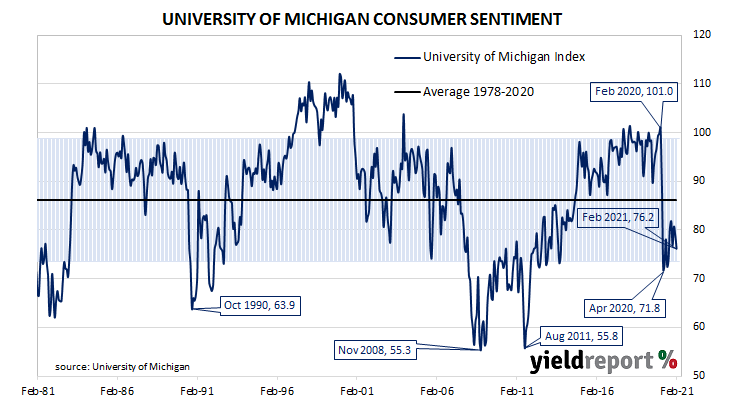Summary: US consumer confidence posts declines for second consecutive month; University of Michigan index below consensus figure; views of present, future conditions both fall; low-income households more pessimistic; short-term inflation expectations rise, highest since 2014.
US consumer confidence started 2020 at an elevated level. However, by March, surveys had begun to reflect a growing uneasiness with the global spread of COVID-19 and its reach into the US. After a plunge in April, US household confidence recovered in a haphazard fashion. Recent reading have consistently remained at below-average levels.
The latest survey conducted by the University of Michigan indicates the average confidence level of US households deteriorated for a second consecutive month in February. The University’s preliminary reading from its Index of Consumer Sentiment registered 76.2, below the generally expected figure of 80.5 and lower than January’s final figure of 79.0. Consumers’ views of current conditions declined while their expectations regarding future conditions fell markedly in comparison to those held at the time of the January survey.
“Consumer sentiment edged downward in early February, with the entire loss concentrated in the Expectation Index and among households with incomes below $75,000,” said the University’s Surveys of Consumers chief economist, Richard Curtin. He noted low-income households “reported significant setbacks in their current finances” while over 50% of higher-income households reported improved finances.

Long-term US Treasury bond yields moved higher on the day. By the close of business, the 10-year yield had added 4bps to 1.21% and the 30-year yield had gained 6bps to 2.01%. The 2-year yield finished unchanged at 0.11%.
ANZ economist Hayden Dimes noted households’ expectations of the one-year inflation rate had increased, rising from 3.0% in January to 3.3%, “its highest level since March 2014.” Longer-term expectations remained unchanged at 2.7%.

